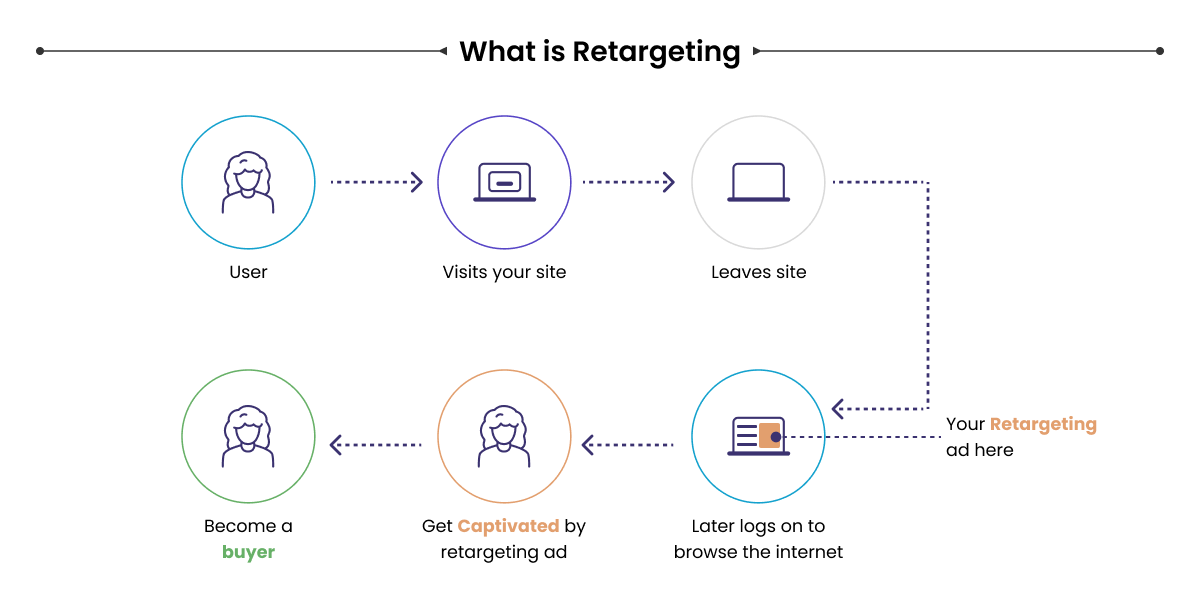Customers today are distracted. It’s difficult to catch their attention and hold on to it throughout their journey with your brand. Many times when a customer doesn’t find what they are looking for on your website, they’ll bounce off without giving your business a second thought. It’s very important to reappear before such visitors to bring them back to your website and convert them.
What is retargeting?

Consider a scenario where you are shopping for your best friend’s birthday at your favorite online store. In the middle of your purchase, you get an urgent client call and move away from the website. In an ideal world where you wouldn’t be reminded of the gift or the website, the online store has lost a customer forever. But luckily, in the real world, businesses can track their website visitors who left their website without completing a conversion goal and reappear in front of them! This is what retargeting is about.
Research says 98% of the visitors who visit your website for the first time leave without making a purchase. Now, if you don’t bring them back, you lose them forever unless they are retargeted.
Retargeting or remarketing is a way of online advertising which helps your brand appear in front of the audience that has bounced off your website without making a purchase. After your website visitors visit specific pages, you can retarget them and show your visitors relevant visual or text ads when they visit other websites. Marketers carry out retargeting for their brands through platforms like Google Ads, LinkedIn Ads, Facebook retargeting, and other retargeting advertising platforms.
So chances are, one day, when you’re mindlessly scrolling through your social media feed, you’ll be reminded of your past incomplete quest for your best friend’s birthday, you’ll head to the online store and complete the purchase. Mission accomplished!
Why is retargeting your website visitors important?
Customers today have a very limited attention span, they are drawn to too many things all at once. When there are hundreds of online clothing stores available, it is highly unlikely that your website visitors will hunt you down to purchase after they have left unless you’ve left a unique impression on them. In marketing, there’s an old principle known as the ‘rule of 7’ that says that a prospective customer has to be exposed to the brand at least seven times before they convert to a paying customer.
While we can’t validate the accuracy of the number or the principle, we can think for ourselves. Do we make a purchase immediately after visiting a website for the first time? No, we look around, compare prices, find reviews of the store and products, evaluate the website based on the experience you get on their website, and then decide whether or not you want to make the purchase. When there are so many parameters you verify, it’s essential that your brand appears before the user and gives them a good experience throughout all the touchpoints.
How does retargeting work?
Retargeting uses a simple Javascript code to anonymously follow your website visitors all over the internet using cookies. You have to place a small piece of code on your website (also called a pixel). This code is unnoticeable to your website visitors and doesn’t affect your website performance. The code drops an anonymous browser cookie whenever a new visitor comes to your website.
Then when your visitors browse the web, the cookie will let your retargeting platform know when to serve ads, these ads are served only to people who have previously visited your website. As your website visitors already showcase some interest while browsing through your website, there are higher chances that they’ll come back with remarketing, hence generating a high return on investment (ROI).
How to use retargeting to improve conversions?
Here are a few tips on how to use retargeting to improve conversions:
- No two users are the same. So your chances of conversions will dynamically increase if you target your audience based on what interests them. This is where audience segmentation plays a part. A granular approach to audience segmentation can help you understand why your website visitors bounce off in the first place.
- Remarketing/retargeting on a shopping cart and abandoned cart pages can boost your conversions. These are the visitors with high purchase intent, hence there are higher chances that they convert with your retargeting campaigns.
- Visitors love offers and discounts. An effective retargeting marketing campaign will be targeted toward visitors who are returning to your website or have viewed specific product pages to encourage purchase.
Conclusion
Retargeting is the process by which users are brought back to your website or platform to attract, engage, or convert after they drop off. Understanding your target audience at a granular level helps you predict what is required to bring them back to your website and boost conversion. Retargeting is a severely underestimated process that has the capability to bring back revenue on a great scale.































